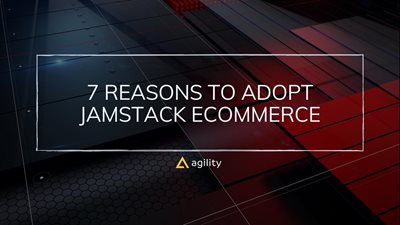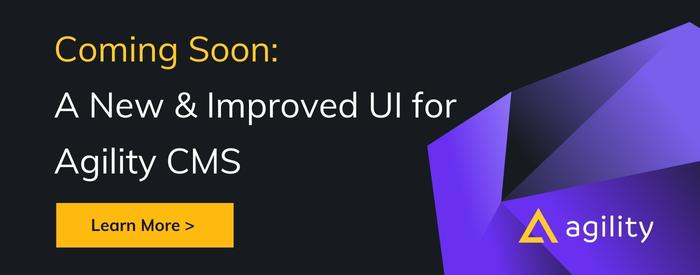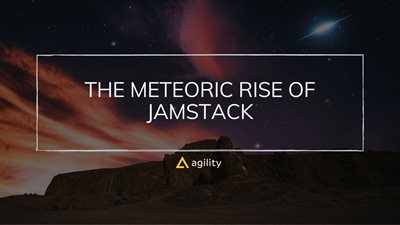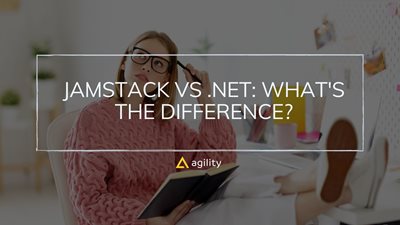7 Reasons to Adopt Jamstack eCommerce


If you're looking to get started with eCommerce, the question of what platform you should use comes up a lot.
Should you build your own or go with something new and different?
The first thing to know is that there's no one-size-fits-all solution. Depending on the size and scope of your business and your goals for the site, there are many options available that will fit your needs.
One option that can work well for both small brands and large companies is Jamstack.
Jamstack offers a low-cost alternative to traditional eCommerce solutions. It removes the need to host your site, freeing up your time and resources while ensuring that your customers shop on a safe and secure platform.
So, in this article, we will discuss what Jamstack is and why Jamstack is the best option for your eCommerce site needs.
What is Jamstack?
"Jamstack" refers to web development techniques that help you build performant, scalable, and robust websites.
You can think of Jamstack as an acronym for the three pillars of modern web development: JavaScript, APIs, and Markup.
Jamstack replaces traditional website structures with a client-side JavaScript framework like React or Vue.
It also uses APIs to create more interactive experiences that devices like smartphones and tablets can access. And finally, it relies on markup languages like HTML and CSS to display content on the screen.
How does Jamstack Work?
Jamstack is a modern way to build fast, secure, and scalable websites. The technology stack allows you to build web apps without all the overhead and complexity of traditional web frameworks.
Here's how each piece of technology works:
- JavaScript: This code runs your website and interacts with the user interface. It powers everything from animations to video players to form validation.
- APIs: These are third-party services that can be integrated into your site - for example, Google Analytics or MailChimp. They allow you to get data from outside sources.
- Markup: This refers to HTML (the language used to create web pages) and CSS (the language used for styling elements within those web pages).
According to the latest Jamstack Community Survey conducted annually by Netlify, eCommerce is one of the biggest drivers of Jamstack adoption, with 34% of users leveraging Jamstack to build eCommerce stores.
They also found that 32% of Jamstack developers are building websites that have audiences numbered in the millions.
Advantages of Building eCommerce Stores Using Jamstack
Here are the reasons why you should consider building eCommerce stores using Jamstack.
1. Better Security
If you’re running an eCommerce store, security should be one of your top priorities. As a merchant, you may need to collect sensitive information, such as credit card numbers, addresses, passwords, etc., from your customers.
You must protect this information at all costs; if not, it could devastate your business and reputation.
While it is true that open-source platforms like WooCommerce and Magento usually come with a long list of security features, there are still several things to keep in mind when protecting your site.
These include hosting environment, regular software updates, daily security checks, and more.
A recent study by Dutch security firm Sansec discovered that over 500 eCommerce stores running the Magento 1 platform had been infected with malware in a single day.
And, it’s not limited to only the Magento platform; any site built on an open-source platform is vulnerable to cyber-attacks.
That’s where Jamstack comes into play.
Jamstack sites are built on a foundation of static HTML, meaning no database or server-side code exists.
Instead, all the content is generated statically and sent to the browser. This generates smaller files, which means faster load times for your site - and less potential for hacking.
2. Improve Performance and User Experience
One of the most significant advantages of building an eCommerce store using Jamstack is that it helps improve performance and user experience.
It is known that traditional eCommerce stores are very slow and take a lot of time to load. This can be frustrating for users as they have to wait for a long time before they can access the store.
However, with Jamstack, you do not need to worry about this problem because it has been designed to load quickly, even on low-end devices.
Jamstack sites are fast because the HTML is already generated during deployment time, and they are served via a CDN without any interference or backend delays.
3. Flexibility in Your Frontend and Backend
If you've spent any time looking at the options for building an eCommerce store, you've probably realized that most of them are pretty limited.
Some platforms do not let you use a custom theme, meaning every page of your site will look the same.
In case you want to switch themes, you will have to rewrite all of your content. It can also be a challenging task to customize the raw code.
However, with Jamstack, you have complete control over both your frontend and backend. As a result, you can use any theme or template from any source - or even write your own.
And when it comes to customization, you have complete access to the code on your site, so there's no limit to what you can do.
4. Lower Costs
It's no secret that eCommerce platforms are expensive to build and maintain. However, as more businesses adopt Jamstack, the cost of developing and maintaining an eCommerce platform decreases.
The reason for this is simple: building on the Jamstack means you no longer have to pay for the backend infrastructure of your eCommerce store.
Instead, you can use a managed service like DigitalOcean or AWS Lambda, which will handle your server maintenance and security needs at a fraction of the cost of traditional hosting.
In addition to reducing the costs of running an eCommerce store, Jamstack also reduces overhead and maintenance costs.
This means you will not have to hire an IT team or spend time maintaining your website; instead, you can focus on growing your business.
5. Convenient for Developers
It's hard to manage a server-side eCommerce platform if you're a developer. Things can go wrong, and you might have to fix them and then update your code.
This could be time-consuming and frustrating, especially if you're working on multiple projects simultaneously.
With Jamstack, developers are relieved of the burden of managing a server. This allows them to get their products out into the world faster and boost sales.
For developers, building a Jamstack store is straightforward. They can use open-source code to create their website without worrying about managing or setting up servers. Instead, they can focus on creating a great eCommerce experience for their customers.
In addition, developers can use pre-existing modules and components already written in JavaScript or TypeScript, so they don't have to spend time writing their code.
6. Scalability is Easier
Another advantage of building eCommerce stores using Jamstack is that they are easily scalable.
When you build a website using Jamstack, it's easy to scale up or down depending on your needs. For example, if you have a surge of traffic, you can add more servers to handle it.
This kind of flexibility is essential because it allows businesses to respond quickly to changing market conditions and customer demands.
You can start with a single website, but if you want to expand, there is no limit to how many stores you can build.
You can also add an unlimited number of products and images to each site without worrying about whether or not it will be too much for your server to handle.
Since all the sites are hosted on the same server, they are built on top of each other like a tower (hence the name).
If one site gets overloaded, it won't affect others. Likewise, if anything goes wrong with one site, it won't affect others either.
7. An Omnichannel Approach
An omnichannel approach allows you to expand your business in any direction and is instrumental in eCommerce.
Jamstack is a platform that enables you to build an eCommerce store and then quickly add other channels like social media and mobile apps.
Once you've built your online store, you can explore other ways to reach customers, such as through Facebook ads or mobile apps.
Jamstack works through microservices - you don't have to use all of the services available at once if they aren't necessary for your business.
For example, if you want to expand into the mobile app market but aren't yet ready to build an app, you can make a simple icon for your website and add more features as time goes by.
Things to Consider Before Using Jamstack in eCommerce
If you're looking for a way to expand your eCommerce business without putting much effort into it, Jamstack might be the solution you need.
But before you jump headfirst into this new technology, there are some things you should consider first.
1. Coding May be Required
Jamstack, while being fully customizable, is not a one-size-fits-all solution. For example, some components of Jamstack require coding and knowledge of a particular programming language (such as HTML, CSS, and JavaScript).
This can be intimidating to some users who don’t have any experience with coding or are just getting started.
2. Not Fully Compatible with Plugins
The Jamstack model uses standardized open-source tools and frameworks, which aren't compatible with most website plugins.
You can find a few exceptions, but generally, you'll need to build your functionality or use a different solution instead of relying on third-party plugins.
3. Not Suitable for Dynamic Environments
Another disadvantage of using Jamstack is that it is unsuitable for dynamic environments.
When we say dynamic, we mean changing content and the environment altogether.
For example, if you are using a website to showcase your products, then every time you change a product, you will have to update the content on your website. If this is done manually, it can be pretty hectic.
4. Preparing a Preview Takes Time
Because of how Jamstack works, creating previews of your work can be very time-consuming.
This can be especially problematic if you need to share your work with clients or colleagues often, as it can be a hassle to keep updating previews each time something changes on the website.
How to Make Jamstack eCommerce Work For You
Jamstack is a platform that allows developers to create eCommerce websites with JavaScript, APIs, and Markup. To do Jamstack work for you, you will need the following things:
1. Use a Static Site Generator
Using a static site generator is the easiest way to create a Jamstack website.
A static site generator is a software that converts your content into HTML pages, which you then upload to a web host.
Static sites are faster and easier to maintain than dynamic ones because they don't require server-side code or databases.
They're also more secure because all the content is hosted on your server, so there's no risk of someone stealing it and publishing it elsewhere.
There are many static site generators, but we recommend using Hugo, Jekyll, and Gridsome.
For your Jamstack website because it's easy to use and supports Markdown syntax (which makes it easier for you to write).
2. Choose a Headless Content Management System (CMS)
A headless CMS is a content management system that doesn't have a front-end interface. Instead, you can use it to create and manage content without worrying about your website's design.
A good headless CMS will make it easy for you to add and edit pages, posts, images, and other content.
If you're looking for a headless CMS, we recommend Agility CMS.
Agility CMS is the best headless CMS because it offers all of the benefits of a traditional CMS.
In addition, it's a fully-featured CMS with a robust feature set that you can use without worrying about server-side code or maintenance.
The best part? Agility comes with a beautiful user interface that makes it easy to use for non-technical users - but it still has all the power of an enterprise-grade content management system.
3. A Content Delivery Network (CDN)
CDNs are networks of servers that deliver web content to users based on their location, which can improve the speed of your site and even save money.
Content delivery networks (CDNs) provide a layer of protection against bandwidth spikes by hosting content on servers worldwide.
Even if your website gets a lot of traffic, your infrastructure doesn't have to bear the brunt of those increased demands. Instead, it can draw from CDN resources.
Some popular CDN options for Jamstack sites are Netlify, Vercel, and Cloudflare.
4. Services / Integrations
Jamstack comes with various integrations and services to help you grow your business.
For example, you can integrate with Stripe or Shopify to process payments or send an email to your customers when they purchase a product.
If you're already using another eCommerce platform, you can easily migrate your store by connecting Shopify with your existing store through the Apps page.
Examples of Jamstack eCommerce Stores
Here are a couple of examples of sites that are built with Jamstack.
- Scotiabank.com.mx
- Hockeycanada.ca
- Sceneplus.ca
Conclusion
Ultimately, the choice of eCommerce technology is up to you. Jamstack offers a great alternative to traditional enterprise eCommerce solutions, and with some planning, it can save you money while providing a better customer experience.
Now that you've learned more about Jamstack, are you ready to implement it for your eCommerce business? If so, try out Agility CMS and see how we can help to achieve your goals.

About the Author
Jyoti Ray is the founder of WPMyWeb.com, which specializes in social media, marketing, and SEO. He writes and has been featured on JeffBullas, SurveyAnyplace, SearchEngineWatch, and more. You can connect with him on LinkedIn.




